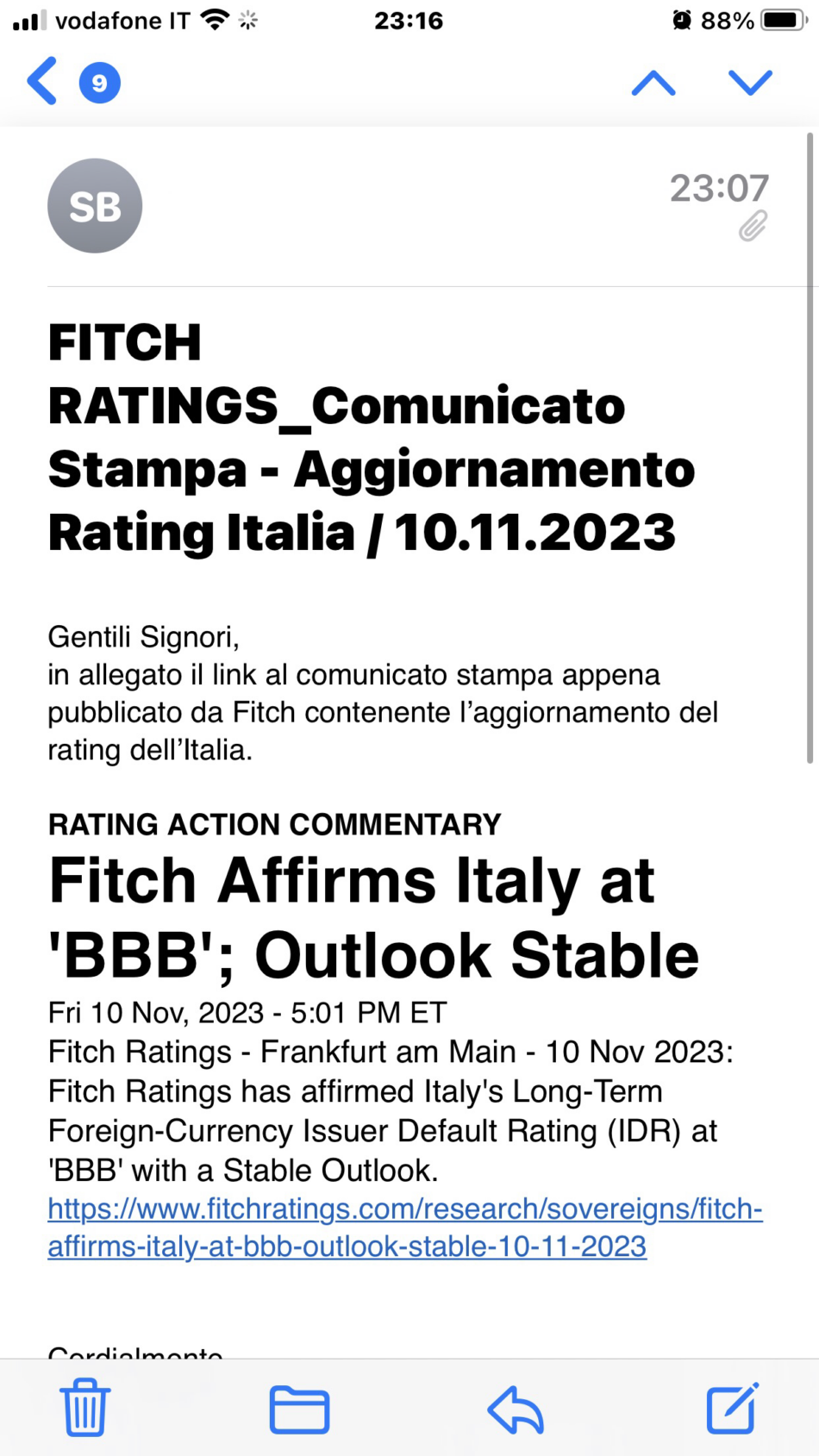Fitch Ratings – Frankfurt am Main – 10 Nov 2023: Fitch Ratings has affirmed Italy’s Long-Term Foreign-Currency Issuer Default Rating (IDR) at ‘BBB’ with a Stable Outlook.
A full list of rating actions is at the end of this rating action commentary.
KEY RATING DRIVERS
Fundamental Rating Strengths and Weaknesses: Italy’s rating is supported by its large, diversified and high value-added economy, eurozone membership, and strong institutions relative to the peer group median. These credit features are balanced against weak macroeconomic and fiscal fundamentals, in particular very high government debt, a comparatively loose fiscal stance since the pandemic, subdued economic growth potential and more recently, the higher yield environment.
Stable Outlook: The Stable Outlook reflects Fitch’s projection for public debt/GDP to stabilise in the outer years of our forecast at near the end-2022 level (and similar to the level projected at our previous review), an expected pick-up in execution of EU-funded projects providing moderate support to growth, and ongoing broad stability of the coalition, which limits more marked policy risk. However, significant loosening of fiscal targets has weakened the deficit adjustment path, with associated risks of higher yields on new debt issuance and non-compliance with EU fiscal rules.
Growth Edging Up, Statistical Revisions: Large statistical revisions in September to GDP in 2020-2022 lifted the level of 2022 GDP by 2%. Fitch forecasts GDP growth slows to 0.9% in 2023, from 3.7% in 2022, following the end of the construction-fuelled private investment, and a moderation in private consumption. We project GDP growth slightly picks up, to 1.0% in 2024 and 1.3% in 2025, helped by an acceleration of NextGenerationEU (NGEU) spending. NGEU execution has markedly underperformed targets this year, but we expect it will be supported by a reprofiling to rationalise sub-national projects and deliver more through the private sector.
Low Trend Growth, Falling Inflation: Fitch assesses Italy’s trend GDP growth at 0.7%, a modest upward revision on our 2021 estimate of 0.6%, due to a greater contribution from capital deepening. This is partly due to the scaling-up of EU-supported investment, but does not factor in significant structural reform progress, which represents an upside risk. Fitch projects inflation, which fell sharply in October to 1.8% (with core inflation more sticky at 4.2%) to average 2.9% in 2024 and 2.1% in 2025.
Significant Loosening of Fiscal Targets: Fitch forecasts a general government deficit of 5.2% of GDP for 2023, from 8.0% in 2022, a 0.8pp upward revision since our last review in May. The underperformance is due to the impact of tax breaks on residential investment exceeding government expectations by 1.1% of GDP. We have also increased our 2024 deficit forecast by 1pp to 4.5% since May, slightly above the government’s new target. The 2024 draft budgetary plan incorporates a net 0.7pp fiscal package, including 0.5pp from a cut in taxes on labour. Fitch projects the deficit narrows to 3.9% of GDP in 2025, driven by recurrent expenditure restraint.
‘Superbonus’ Accounting Flatters Future Deficits: The accounting reclassification in March that records the cost of ‘Superbonus’ tax credits in 2020-2022 in the year that they are granted rather than used, and the recent decision to treat 2023 the same way, has resulted in a 1.6pp rise in average deficits in those years, with a consequent deficit-reducing impact in subsequent years. On a cash basis, costs in 2024-2026 will therefore be above those implied by fiscal deficits, which explains our incorporation of overall debt-increasing stock-flow adjustments averaging 1.1% of GDP over the period (also assuming lower privatisation receipts than the 1% of GDP cumulatively in government projections).
Debt/GDP Rises Slightly in 2024/2025: Fitch forecasts general government debt/GDP to fall 1.4pp this year to 140.3%, less than the 2.2pp at our last review, which compares with the ‘BBB’ median of 54.9%. We project debt/GDP then gradual rises to 141% at end-2025, as higher debt serving and stock-flow adjustments offset the 1.7pp improvement in the primary surplus (driven by the tailing off of the superbonus scheme). However, given the ISTAT statistical revisions to GDP lowered the end-2022 debt/GDP ratio by almost 3pp, our end-2025 debt forecast is still 0.6pp lower than we projected in May.
Growth-Interest Differential to Turn Negative: We expect government debt interest/GDP to fall 0.4pp in 2023 to 3.9% of GDP, on lower cost of inflation-linked bonds (10.8% of total debt). Given the surge in government bond yields (with average refinancing costs of 4.2% in October), we forecast interest spending to then rise, to 4.3% of GDP in 2025, with the growth-interest rate differential turning negative in 2026. Under our longer-term debt projections, which assume a cumulative 0.9pp improvement in the primary balance in 2026 and 2027, general government debt stabilises at 141.6% of GDP in 2027, helped by lower stock-flow adjustments.
Uncertainty from EU Fiscal Rules: We see a sizeable risk that Italy enters an Excessive Deficit Procedure after EU fiscal rules come back into force, given its fiscal deficit does not fall below 3% of GDP until 2026 under government plans. We judge there is a significantly lower probability that this would result in Italian bonds becoming ineligible for the ECB Transmission Protection Instrument (TPI) given the possibility that Italy’s adjustment while in EDP (including its structural deficit reduction) would constitute effective action, a key input under TPI rules. However, the application and timing of EU fiscal rules are currently subject to a very high degree of uncertainty.
Relatively Stable Political Position: Public support for the Meloni government has held up and its parliamentary majority is more stable than many previous administrations, providing a platform for medium-term economic and fiscal planning. However, it also faces sizeable political pressure to deliver more of its electoral pledges, weighing on prospects for greater consolidation, as evidenced by current coalition push-back on pension reform measures.
Broadly Stable External Finances: Fitch forecasts a slight improvement in the current account surplus to 0.8% of GDP in 2025, from 0.2% in 2023, on an improved energy balance and strengthening demand for exports. While net external debt, projected at 47.1% of GDP at end-2023, is well above the ‘BBB’ median of 2.6%, Italy has a positive international investment position, which moderately improved in 1H23, to 5.3% of GDP.
Sound Banking Sector: The Italian banking sector has strengthened in recent years. The gross impaired loan ratio, on Fitch’s definition, was stable in 2023 at near 3% (end-June), a decade low. Default rates are benign (including on government guaranteed loans) and although we expect some rise, higher interest rates will support banks’ performance, despite weak loan demand. Revenues are more diversified, capital metrics have improved, and the new bank tax will support CET1. Banks are typically funded through granular and mostly insured customer deposits, which will become more expensive but are fundamentally stable, and we expect TLTRO reimbursement to remain manageable.
ESG – Governance: Italy has an ESG Relevance Score (RS) of ‘5[+]’ for both Political Stability and Rights and for the Rule of Law, Institutional and Regulatory Quality and Control of Corruption. Theses scores reflect the high weight that the World Bank Governance Indicators (WBGI) have in our proprietary Sovereign Rating Model. Italy has a high WBGI ranking at the 67th percentile, reflecting its long track record of stable and peaceful political transitions, well established rights for participation in the political process, strong institutional capacity, effective rule of law and a low level of corruption
RATING SENSITIVITIES
Factors that Could, Individually or Collectively, Lead to Negative Rating Action/Downgrade
– Public Finances: Weaker confidence in the implementation of primary balance adjustments necessary to contain fiscal sustainability risks, in the context of Italy’s high debt burden.
– Macro/Public Finances: Further and persistent deterioration of government financing conditions that exacerbates debt sustainability concerns, for example due to a broader tightening of market conditions or more specifically linked to Italy’s eligibility for the TPI.
– Macro: Signs of weakening of growth potential due, for example, to marked delays in execution of NGEU-led investment and/or failure to implement structural reforms.
Factors that Could, Individually or Collectively, Lead to Positive Rating Action/Upgrade
– Public Finances: Medium-term fiscal consolidation that supports a substantial decline in Italy’s government debt/GDP.
– Macro: Increase in medium-term growth potential, for example due to the implementation of growth-enhancing structural reforms.
SOVEREIGN RATING MODEL (SRM) AND QUALITATIVE OVERLAY (QO)
Fitch’s proprietary SRM assigns Italy a score equivalent to a rating of ‘A-‘ on the Long-Term Foreign-Currency (LT FC) IDR scale.
Fitch’s sovereign rating committee adjusted the output from the SRM to arrive at the final LT FC IDR by applying its QO, relative to SRM data and output, as follows:
– Macro: -1 notch, to reflect Italy’s low GDP growth potential, partly due to adverse demographic trends.
– Public Finances: -1 notch, to reflect very high government debt levels. The SRM is estimated on the basis of a linear approach to government debt/GDP and does not fully capture the risk at high debt levels.
Fitch’s SRM is the agency’s proprietary multiple regression rating model that employs 18 variables based on three-year centred averages, including one year of forecasts, to produce a score equivalent to a LT FC IDR. Fitch’s QO is a forward-looking qualitative framework designed to allow for adjustment to the SRM output to assign the final rating, reflecting factors within our criteria that are not fully quantifiable and/or not fully reflected in the SRM.
COUNTRY CEILING
The Country Ceiling for Italy is ‘AA’, 6 notches above the LT FC IDR. This reflects very strong constraints and incentives, relative to the IDR, against capital or exchange controls being imposed that would prevent or significantly impede the private sector from converting local currency into foreign currency and transferring the proceeds to non-resident creditors to service debt payments.
Fitch’s Country Ceiling Model produced a starting point uplift of +3 notches above the IDR. Fitch’s rating committee applied a further +3 notches qualitative adjustment to this, under the Long-Term Institutional Characteristics pillar reflecting the sovereign’s membership of the eurozone currency union and the associated reserve currency status. The agency views the risk of imposition of capital or exchange controls within the eurozone as exceptionally low.
REFERENCES FOR SUBSTANTIALLY MATERIAL SOURCE CITED AS KEY DRIVER OF RATING
The principal sources of information used in the analysis are described in the Applicable Criteria.
ESG CONSIDERATIONS
Italy has an ESG Relevance Score of ‘5[+]’ for Political Stability and Rights as World Bank Governance Indicators have the highest weight in Fitch’s SRM and are therefore highly relevant to the rating and a key rating driver with a high weight. As Italy has a percentile rank above 50 for the respective Governance Indicator, this has a positive impact on the credit profile.
Italy has an ESG Relevance Score of ‘5[+]’ for Rule of Law, Institutional & Regulatory Quality and Control of Corruption as World Bank Governance Indicators have the highest weight in Fitch’s SRM and are therefore highly relevant to the rating and are a key rating driver with a high weight. As Italy has a percentile rank above 50 for the respective Governance Indicators, this has a positive impact on the credit profile.
Italy has an ESG Relevance Score of ‘4[+]’for Human Rights and Political Freedoms as the Voice and Accountability pillar of the World Bank Governance Indicators is relevant to the rating and a rating driver. As Italy has a percentile rank above 50 for the respective Governance Indicator, this has a positive impact on the credit profile.
Italy has an ESG Relevance Score of ‘4[+]’ for Creditor Rights as willingness to service and repay debt is relevant to the rating and is a rating driver for Italy, as for all sovereigns. As Italy has track record of 20+ years without a restructuring of public debt and captured in our SRM variable, this has a positive impact on the credit profile.
Italy has an ESG Relevance Score of ‘4’ for Demographic Trends. Aging costs will increase significantly over the next 10-15 years, due partly to adverse demographic trends. Accordingly, this has a negative impact on the credit profile, is relevant to the rating and a rating driver.
The highest level of ESG credit relevance is a score of ‘3’, unless otherwise disclosed in this section. A score of ‘3’ means ESG issues are credit-neutral or have only a minimal credit impact on the entity, either due to their nature or the way in which they are being managed by the entity. Fitch’s ESG Relevance Scores are not inputs in the rating process; they are an observation on the relevance and materiality of ESG factors in the rating decision. For more information on Fitch’s ESG Relevance Scores, visit








